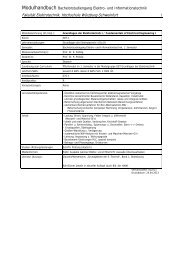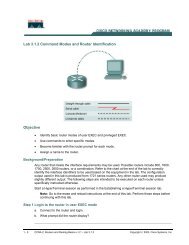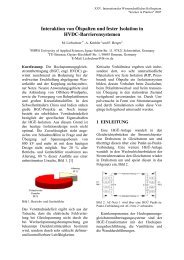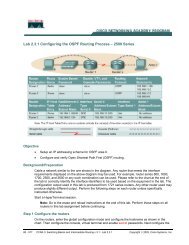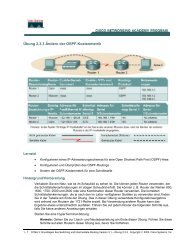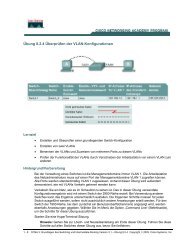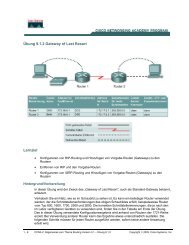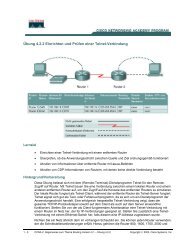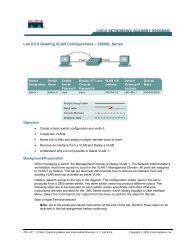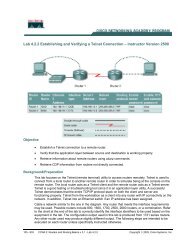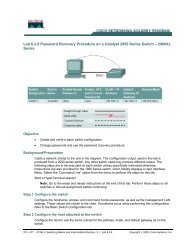Designing Special IIR-Filters by Approximating the Magnitude ...
Designing Special IIR-Filters by Approximating the Magnitude ...
Designing Special IIR-Filters by Approximating the Magnitude ...
Create successful ePaper yourself
Turn your PDF publications into a flip-book with our unique Google optimized e-Paper software.
<strong>Designing</strong> <strong>Special</strong> <strong>IIR</strong>-<strong>Filters</strong> <strong>by</strong> <strong>Approximating</strong> <strong>the</strong> <strong>Magnitude</strong> Frequency<br />
Characteristic of an Analogue Prototype System<br />
Peter Möhringer, Tristan Schneider,<br />
Faculty of Electrical Engineering<br />
University of Applied Sciences<br />
Fachhochschule Würzburg-Schweinfurt<br />
D-97421 Schweinfurt, Ignaz-Schön-Str. 11<br />
Germany<br />
pmoehrin@fh-sw.de<br />
Abstract - The design of special <strong>IIR</strong>-filters using<br />
optimization procedures is a well known practice. In<br />
<strong>the</strong> following, a combination of approximation and<br />
transformation is proposed for <strong>the</strong> design of digital<br />
<strong>IIR</strong>-filters with special demands for <strong>the</strong> magnitude<br />
frequency characteristic. The design is realized <strong>by</strong><br />
four steps. The desired squared magnitude<br />
characteristic via frequency is defined for <strong>the</strong> digital<br />
filter, first. Then <strong>the</strong> prescription is transformed to<br />
<strong>the</strong> analogue domain <strong>by</strong> inverse bilinear transform,<br />
this is followed <strong>by</strong> an optimization procedure of <strong>the</strong><br />
analogue frequency response. Finally <strong>the</strong> optimized<br />
result is transformed back to <strong>the</strong> digital domain<br />
yielding <strong>the</strong> desired <strong>IIR</strong>-filter.<br />
I. INTRODUCTION<br />
Starting with <strong>the</strong> definition of <strong>the</strong> desired<br />
magnitude frequency characteristic digital <strong>IIR</strong><br />
filters are designed using <strong>the</strong> bilinear transform to<br />
allow an optimization in <strong>the</strong> analogue domain. The<br />
appropriately selected function yields stable<br />
systems, automatically and <strong>the</strong> nonlinear distortion<br />
of <strong>the</strong> frequency axis is equalized <strong>by</strong> using <strong>the</strong><br />
bilinear transform back and forth. First, from digital<br />
to analogue domain and second, after <strong>the</strong><br />
optimization, back to <strong>the</strong> digital domain again. A<br />
program for MATLAB was developed and <strong>the</strong><br />
capability of <strong>the</strong> method was tested <strong>by</strong> optimizing a<br />
digital to analogue converter equalizing filter.<br />
[1,2,3]<br />
II. THE DESIGN METHOD<br />
First we define <strong>the</strong> magnitude characteristic of <strong>the</strong><br />
desired filter in <strong>the</strong> digital domain. This design<br />
goal HW(jω) is squared and <strong>the</strong>n transformed to <strong>the</strong><br />
analogue domain <strong>by</strong> means of <strong>the</strong> bilinear<br />
transformation following equ. (1). In <strong>the</strong> analogue<br />
domain we choose an appropriate complex<br />
function, e. g. Hist(s 2 ) as proposed in [2]. The<br />
chosen function is a separable product of a stable<br />
system H(s) and an instable system H(-s). See equ.<br />
(2). Optimizing Hist(s 2 ) using a least squares<br />
method to approximate <strong>the</strong> required frequency<br />
characteristic and hereafter separating <strong>the</strong> stable<br />
system H(s) from <strong>the</strong> product are <strong>the</strong> next steps.<br />
Fig. 1 shows <strong>the</strong> poles and <strong>the</strong> zeroes of an<br />
example system combination H(s)H(-s). The stable<br />
system is selected <strong>by</strong> taking <strong>the</strong> poles in <strong>the</strong> left<br />
open half plane and splitting <strong>the</strong> double zeroes on<br />
<strong>the</strong> imaginary axis for H(s) and H(-s).<br />
z −1<br />
1 + s<br />
s = ; z =<br />
(1)<br />
z + 1 1 − s<br />
(2)<br />
(3)<br />
Fig. 1: Poles and zeroes of <strong>the</strong> analogue system<br />
Hist(s 2 )<br />
omega-analog<br />
6<br />
5<br />
4<br />
3<br />
2<br />
1<br />
bilinear transform axis distortion<br />
0<br />
0 0.2 0.4 0.6 0.8 1 1.2 1.4<br />
omega-digital<br />
Fig. 2. Distortion of <strong>the</strong> frequency axis
D →<br />
A<br />
s =<br />
z − 1<br />
z + 1<br />
equ .( 4)<br />
ω A = tan( ω D T / 2)<br />
A → D<br />
1 + s<br />
z =<br />
1 − s<br />
jω<br />
DT<br />
e<br />
1 +<br />
=<br />
1 −<br />
jω<br />
A<br />
jω<br />
A<br />
equ .( 5)<br />
ω D<br />
2<br />
= arctan( ω A )<br />
T<br />
Equations (4) and (5)<br />
In <strong>the</strong> following step,<br />
<strong>the</strong> analogue filter is<br />
transformed back to<br />
<strong>the</strong> digital domain,<br />
again using <strong>the</strong><br />
bilinear transform and,<br />
thus equalizing <strong>the</strong><br />
distortion of <strong>the</strong><br />
frequency axis. See<br />
Fig. 2 and equ. (4) and<br />
equ. (5) The effect of<br />
distortion of <strong>the</strong><br />
frequency axis and its<br />
equalization are<br />
explained in Fig. 3.<br />
The poles and zeroes<br />
of a resulting digital<br />
system HDist are shown<br />
in Fig. 4.<br />
Fig. 3. Distortion and equalization of <strong>the</strong><br />
frequency axis.<br />
top: desired digital characteristic, normalized<br />
middle: transformed to <strong>the</strong> analogue domain<br />
bottom: back in <strong>the</strong> digital domain, fa=44.1kHz<br />
Although <strong>the</strong> bilinear transform is commonly not<br />
applicable for <strong>the</strong> design of equalizing filters, <strong>the</strong><br />
way of using <strong>the</strong> transform back and forth allows a<br />
wide variety of designs, avoiding <strong>the</strong> distortion of<br />
<strong>the</strong> frequency axis.<br />
Fig. 4 poles and zeroes of a resulting digital<br />
system.<br />
III. DESIGN OF A POST DAC FILTER<br />
To show <strong>the</strong> capability of <strong>the</strong> proposed method, a<br />
digital to analogue converter equalizing filter (DAC<br />
filter) was designed<br />
H DA ( jω)<br />
T<br />
sin ω<br />
=<br />
2<br />
T<br />
ω<br />
2<br />
(6)<br />
and measured. The magnitude frequency<br />
characteristic of <strong>the</strong> DAC HDA(jω), equ. (6), shall<br />
be equalized in <strong>the</strong> passband and <strong>the</strong> step function<br />
shall be smoo<strong>the</strong>d, thus suppressing <strong>the</strong> aliasing<br />
spectra. The desired frequency response HW(jω) is<br />
defined in equ. (7) and <strong>the</strong> squared response is<br />
shown in Fig. 5.<br />
H<br />
0<br />
W<br />
T<br />
sin ω<br />
( jω)<br />
=<br />
2<br />
T<br />
ω<br />
2<br />
−1<br />
ωωa/2<br />
IV. MEASURED RESULTS<br />
Finally <strong>the</strong> example <strong>IIR</strong>-filter was implemented on<br />
a signal processor test board and frequency<br />
response as well as pulse response were measured<br />
and compared to <strong>the</strong> desired solution. Fig. 6 shows<br />
<strong>the</strong> measuring circuit. The DAC of <strong>the</strong> test board<br />
was used for <strong>the</strong> distortion and <strong>the</strong> tested filter<br />
frequency response is used for <strong>the</strong> equalizing. The<br />
plot in Fig. 7 shows <strong>the</strong> product result of DAC<br />
magnitude distortion and <strong>the</strong> equalizer. As can be<br />
seen, <strong>the</strong> desired characteristic is closely met.
Fig. 5. The squared frequency response, <strong>the</strong><br />
optimized result and <strong>the</strong> difference<br />
Fig. 6. Measuring circuit for time and frequency<br />
response<br />
V. CONCLUSION<br />
As was shown <strong>by</strong> example, <strong>the</strong> combination of a<br />
well known classic analogue filter design method<br />
and <strong>the</strong> bilinear transform used back and forth<br />
yields <strong>IIR</strong> digital filters closely meeting <strong>the</strong> desired<br />
prescriptions. The method was programmed in<br />
Fig. 7. Measured frequency characteristic,<br />
product of DAC and filter frequency response<br />
MATLAB and results were tested <strong>by</strong> implementing<br />
<strong>the</strong> resulting filters on a signal processor board and<br />
measuring <strong>the</strong> overall performance.<br />
VI. ACKNOWLEDGMENT<br />
<strong>Special</strong> thanks for review and support in layout to<br />
H. Endres, P. Dückert and Stefanie Möhringer<br />
VII. REFERENCES<br />
[1] Schüßler H.W.: „Digitale Systeme zur<br />
Signalverarbeitung“, Springer Verlag 1973<br />
[2] Möhringer P.: „Beitrag zum Entwurf von<br />
Filtern zur A/D- und D/A-Wandlung”,<br />
Dissertation Uni Erlangen/Nürnberg 1982<br />
[3] Schneider, T.: „Entwurf rekursiver Digitalfilter<br />
mit besonderer Anforderung an den<br />
Frequenzgang“, Diplomarbeit, University of<br />
Applied Sciences FH-WS 2007<br />
VIII. THE AUTHORS<br />
Prof. Dr.-Ing. Peter Möhringer, University of<br />
Applied Sciences, Fachhochschule Würzburg-<br />
Schweinfurt, is head of <strong>the</strong> communication systems<br />
branch of <strong>the</strong> faculty of electrical engineering.<br />
Dipl.-Ing. (FH) Tristan Schneider developed <strong>the</strong><br />
program, provided <strong>the</strong> examples and did <strong>the</strong><br />
measurements in <strong>the</strong> frame of his diploma <strong>the</strong>sis.<br />
IX. APPENDIX<br />
Poles and zeroes of <strong>the</strong> tested equalizing filter.<br />
Analogue prototype and <strong>the</strong> digital <strong>IIR</strong> filter result.<br />
Analogue prototype of degree 5<br />
Zeroes: Poles:<br />
0 + 5.6707j -6.1801<br />
0 + 5.971j -0.82268 - 2.2j<br />
0 - 5.6707j -0.82268 + 2.2j<br />
0 - 5.971j -5.5708 + 0.3j<br />
-5.5708 - 0.3j<br />
Resulting digital <strong>IIR</strong> filter of degree 5<br />
Zeroes: Poles:<br />
-1 -0.51101<br />
-0.77874 + 0.62735j -0.11843 - 0.6871j<br />
-0.77874 - 0.62735j -0.11843 + 0.6871j<br />
-0.79825 + 0.60233j -0.47248 + 0.020903j<br />
-0.79825 - 0.60233j -0.47248 - 0.020903j




